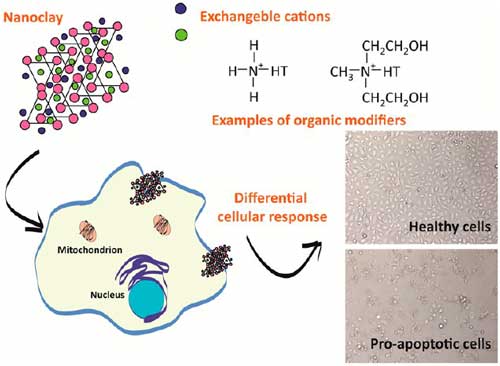| Posted: Sep 07, 2017 | |
Assessing the toxicity of nanoclay(Nanowerk News) With an estimated growth rate of about 25% annually, nanocomposites or composites containing nanoclays incorporated into polymers are expected to have wide implementation in commercial and industrial products, from food packaging materials to automotive and medical devices. In food packaging, for instance, nanoclays are organically modified to allow for better exfoliation within the polymer matrix at a low silicate weight percent, leading to commercial applications of almost 70% of the market volume. |
|
| Some of the most common nanoclays used in food packaging are Nanomer I.31PS, Nanomer I.34TCN, and Nanomer I.44P. Researchers at West Virginia University now have designed a systematic study to help determine the potential for inhalation toxicity of the three organically modified Nanomer nanoclays currently used for food packaging applications. | |
| This study, just reported in a paper in ACS Applied Materials & Interfaces ("Early Assessment and Correlations of Nanoclay’s Toxicity to Their Physical and Chemical Properties"), uses human immortalized bronchial epithelial cells (BEAS-2B) and primary small airway epithelial cells (SAECs) as established cell lines for assessing toxicity induced via inhalation because they have previously helped assess toxicity of graphene nanoparticles, asbestos, and carbon nanotubes. | |
 |
|
| "The SAEC model expands the impact of our study to a more human-related biological platform as primary cells more closely mimic their tissue of origin and further reduce misidentification, contamination, general genetic instability, and lack of functions and markers often encountered with immortalized cellular systems," the researchers note. | |
| Additionally, through the use of two epithelial lung cell lines, the scientists were able to further assess the potential toxicity of nanoclays when they deposit in both the bronchioles and distal airways near the terminal bronchiole and alveolar duct, respectively. | |
| Systematic assessment maps and correlates the physical and chemical properties of nanoclays at two points in their life cycle (i.e., production/manufacturing or the end of their life cycle) with their potential to induce toxicity for a better understanding of how nanoclays’ deleterious interactions with the cellular systems can be reduced so safe yet effective materials can be produced and implemented in commercial sectors. | |
| "Our study showed that the chemical composition of individual organic modifiers used for nanoclay functionalization played a large role in their interactions with cellular systems," the authors conclude their report. "Specifically, differences in organic modifiers caused differential size distributions in dispersion cellular media and differential degrees of toxicity upon their or thermally degraded byproducts exposure to lung epithelial cells. Understanding how the physical and chemical properties of such materials influence toxicity can aid in safer design functionalities while still maintaining beneficial properties to make them miscible with polymer matrixes for food packaging applications." |
 By
Michael
Berger
– Michael is author of three books by the Royal Society of Chemistry:
Nano-Society: Pushing the Boundaries of Technology,
Nanotechnology: The Future is Tiny, and
Nanoengineering: The Skills and Tools Making Technology Invisible
Copyright ©
Nanowerk LLC
By
Michael
Berger
– Michael is author of three books by the Royal Society of Chemistry:
Nano-Society: Pushing the Boundaries of Technology,
Nanotechnology: The Future is Tiny, and
Nanoengineering: The Skills and Tools Making Technology Invisible
Copyright ©
Nanowerk LLC
|
|
|
Subscribe to a free copy of one of our daily Nanowerk Newsletter Email Digests with a compilation of all of the day's news. |
